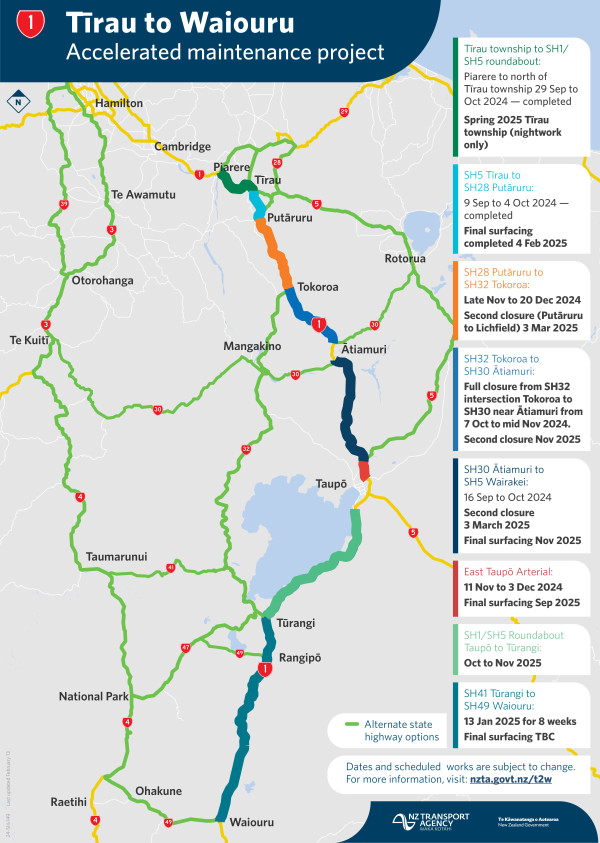
One of the largest and most ambitious maintenance projects undertaken in New Zealand started in September 2024 on State Highway 1 in central and southern Waikato. Sections of SH1 from just north of Tīrau to Waiouru are the focus of accelerated maintenance over a 16-month period.
SH1 through central and southern Waikato is an important route within our highway network. The last few years have seen an increase in the number of potholes and many sections of this route are in the worst condition of all highways in Waikato.
To hold the current condition an increase in basic maintenance would be required but this project will go further by preventing further deterioration in roading quality and bringing the road up to a higher standard. By doing more intense rebuilding, the overall condition and longevity of SH1 can be improved. Funding will come from the new State Highway Pothole Prevention activity class.
This project will use block closures in many areas to expedite delivery and reduce the length of time people are affected by temporary traffic management while we repair the road. Block closures will ensure cost effective delivery, resulting in significant savings compared to the current programme. As well as road rebuilding, other work such as drainage and vegetation control will be undertaken at the same time.
By taking this new approach, the programme for 110 lane kms of work can be condensed from over 4 years to approximately 16 months. The result will be a superior highway with less maintenance and patching required in the future. The treatments will be designed to not only meet expected traffic growth, but to have a long-term life, ensuring resilience.
The section of SH1 between Tīrau and Waiouru, which is the focus of this accelerated maintenance work, is 220km long. Approximately 14,600 vehicles use the northern end of this section of highway per day, including up to around 2,500 heavy vehicles. At the southern end of Desert Road there are approximately 4,000 vehicles per day, including 940 heavy vehicles.
New Zealanders want a well maintained and reliable transport network. This critical route is not currently in an acceptable condition. Between SH29 at Piarere and SH49 at Waiouru 5,670 potholes were repaired between July 2022 and April 2024. That meant a lot of road works disrupting traffic.
We have heard how disruptive multiple road work sites and traffic delays can be, especially for the freight industry. We know that having reliable, predictable journey times is important to everyone. Hitting potholes on our main highway is also unacceptable.
By going beyond basic maintenance, we can prevent further deterioration in roading quality. Taking a different approach of more intense repairs and rebuilding rather than just pothole fixing will result in roads of a higher standard.
Our objective is to have a stronger road, less prone to potholes. This new approach to fixing and improving the sections rated as very poor on this SH1 corridor includes:
This approach also means efficiency gains, considerable cost savings and increased productivity. Using block road closures will:
There would be an increased spend (estimated $42m) in the first 2 years but condensing over 4 year’s work into 16 months will save an estimated $13.8 million. Longer term, by making these improvements on the highway in such a concentrated manner, we can reduce the amount of future road closures. Calculations show that over 25 years the savings are estimated at $141m in 2024 dollars and $291m if we assume 3% escalation each year.
Road maintenance always comes with some disruption to people. On the positive side, there will be a 16-month period of inconvenience across this SH1 corridor, and then a considerably longer period when there is far less roadworks in the future.
We recognise and acknowledge there will be inconvenience and disruption to people while this work is carried out, especially locals and businesses on SH1 and the detour routes. We will engage with residents and business owners to understand the impacts potential closures and detours will have. We will then investigate if we can address these in our planning. We cannot guarantee that there will not be an impact on businesses who rely on through-traffic while we undertake this necessary and important work.
We are committed to ensuring communities are fully informed of the schedule and impacts with as much notice given as possible. Block closures will have allowances for emergency services, locals and their suppliers to go about their ordinary journeys as much as possible, and access given to towns and centres. Work required in any town centres will be done under night closure only, to lessen disruption to the town’s daytime activities.
We are and will continue to work closely with the local councils, iwi, freight industry, emergency services, bus companies and tourism organisations on this planning. Work is underway to ensure alternative routes are suitable for the increased traffic volumes.
Monitoring travel times and traffic counts on SH1 and alternative routes will be part of ongoing network monitoring and reporting.
We acknowledge that people will need to be patient and understanding over the next 16 months, but the longer-term result will be worth it – Waikato’s main highway will be a source of pride for us all.
Close
View larger map of the accelerated maintenance project [PDF, 248 KB]
For details on the works, see our Works programme page
Close